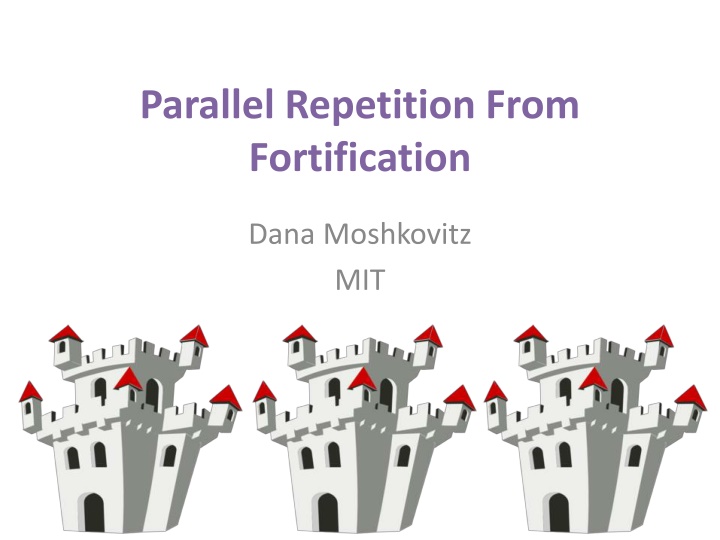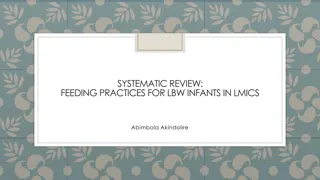
Research on Parallel Repetition in Two-Prover Games
Discover the complexities of parallel repetition in two-prover games through research on fortifications, coloring games, and non-interactive agreement verifiers. Explore the NP-hardness, PCP theorem, and various results from the last twenty-five years in this field.
Download Presentation

Please find below an Image/Link to download the presentation.
The content on the website is provided AS IS for your information and personal use only. It may not be sold, licensed, or shared on other websites without obtaining consent from the author. If you encounter any issues during the download, it is possible that the publisher has removed the file from their server.
You are allowed to download the files provided on this website for personal or commercial use, subject to the condition that they are used lawfully. All files are the property of their respective owners.
The content on the website is provided AS IS for your information and personal use only. It may not be sold, licensed, or shared on other websites without obtaining consent from the author.
E N D
Presentation Transcript
Parallel Repetition From Fortification Dana Moshkovitz MIT
Coloring Two Prover Projection Game: Given graph G=(V,E), 1. Pick uniformly v V and two edges {v,u},{v,u } E. 2. Each prover gets an edge. Answers: colors for endpoints. 3. Check that the two provers agree on the color of v. val(G) = max P(verifier accepts) NP-hardness: It is NP-hard, given a game, to distinguish between val(G)=1 and val(G)<1. PCP Theorem: It is NP-hard, given a game, to distinguish between val(G)=1 and val(G)<0.99. {v,u} {v,u } v, u v, u 0.01?
Parallel Repetition: Sequential repetition with two provers?? Product game Gk e1, ,ek e1 , ,ek a1, ,ak a1 , ,ak val(Gk) val(G)k The Parallel Repetition Problem: val(Gk) val(G)k ??
Twenty Five Years of Parallel Repetition Research Current result: Can engineer projection G so val(Gk) val(G)k+ Raz: If val(G G)=1- & players answers in , val(G Gk) (1- ( 32))k/2log| |. Problem posed by Fortnow, Rompel, Sipser Dinur,Steurer: For projection games, val(Gk) (2val(G))k/2. Holenstein simplifies! If val(G)=1- & players answers in , val(Gk) (1- ( 3))k/2log| |. Partial results Special cases analyzed 1990 1994 2007 2014 Feige,Kilian: Engineer G so val(Gk) poly(1/k). Rao: For projection games, if val(G)=1- & players answers in , val(Gk) (1- ( 2)) (k). Raz-Rosen: If G projection game on expander & val(G)=1- , val(Gk) (1- ) (k). Raz: 2 is tight! Impagliazzo,Kabanets,Wigderson: Feige-Kilian engineering of G yields val(Gk) exp(- ( k)).
Basics of Two Prover games [BGKW88] A game G is defined by: X = set of questions. = set of answers. R = randomness strings. PickTest : R X X. : R {accept,reject}. Hardness of approximation is based on projection games (aka Label Cover). Val(G) determines the hardness factor. Size(G)=|R|- determines reduction blow-up. Alphabet size = | | - also effects the blow-up. uniform neighbors x,x X ; (r,a,a ) accepts if f(x,y)(a)=f(x ,y)(a ). there is a set Y, labels L for Y, a bipartite graph G=(X,Y,E), and functions {fe: L}. PickTest picks a uniform y Y and two
Parallel Repetition Might Not Decrease Value Feige s Non-Interactive Agreement Verifier picks random bits as x, x . Each player should respond (player,bit). Verifier accepts if both answered same player and his input bit. 0 1 Wang,0 Wang,0 Wang Mang val(NIA) = . val(NIA2) = ?
val(NIA2) = val(NIA) = 1/2 x1,x2 x1 ,x2 Wang,x2 Mang,x2 Wang,x1 Mang,x1 Wang Mang Verifier accepts in first round with prob 1/2. Conditioned on acceptance in first round, x1=x2 , i.e., probability 1 of acceptance in second round.
Parallel Repetition is Subtle val(G2)=P(x1,x1 agree) P(x2,x2 agree|x1,x1 agree) We focus on a sub-game of G where x1,x1 agree. Its value might be much higher than val(G).
This Work: Engineer The Game so Parallel Repetition Sequential Repetition -Fortification: Simple, natural, transformation on projection games; maintains the value of the game, somewhat increases size and alphabet. fortified G G repeat Parallel repetition theorem: for -fortified G, poly( )(#labels)-k val(Gk) val(G)k+O(k )
Implication to PCP Combinatorial PCP with Low Error Starting from [Dinur 05]: combinatorial projection PCP with arbitrarily arbitrarily small constant error. Implies that for any >0, it is NP-hard to approximate Max-SAT to within 7/8 + [H stad 97]. In general: sufficient to determine approximation threshold for many optimization problems.
Fortification The verifier picks questions to provers x, x as before. Picks extra questions {x1, ,xw}, x {x1, ,xw} and {x1 , ,xw }, x {x1 , ,xw }, where w=poly(1/ ). Sets of questions picked using extractor on X. E.g., random walk on a constant-degree expander on X. The provers answer all questions; the verifier only checks the answers to x, x . - In Feige-Kilian s Confuse and Compare w=2. - In parallel repetition independence between the k tests seems essential. x1, ,xw x1 , ,xw a1, ,aw a1 , ,aw
Dfn: Fraction rectangular sub-games: questions of each prover restricted to fraction subset. Dfn: -fortified: value of all fraction rectangular sub-games of G at most val(G)+ . Lem: The transformed game is -fortified (from extractor property). Extractors: Not every projection game on extractor is fortified. Size: Fortification increases size before repeating, but (size exp(poly(1/ )))k less than size2k. Alphabet: Provers give w times more answers where w=poly(1/ ). In repetition only k log(1/ ) times more answers. Projection: Fortification preserves projection, but not necessarily uniqueness.
Squaring: For -fortified G, /(2#colors) val(G2) val(G)2 +2 Proof: Assume by way of contradiction a strategy for G2 that does better. Suppose that in G2 answers to x1 x1 should agree on y1 & answers to x2 x2 should agree on y2. 1. Conditioning: P(agree on y2 |agree on y1) > val(G)+2 . 2. Sub-game: Fix questions x1,x1 ,y1 & label to y1. Define: S := { x2 | (x1,x2) assigns y1 } T := { x2 | (x1 ,x2 ) assigns y1 } 3. Small Prob Events: For s.t. |S |< |X| or |T |< |X| probability that x2 S or x2 T is <2 . Contribution of such is < 2 #colors .Consider other . 4. Fortification: value of G restricted to S ,T is val(G)+ . 5. Overall: P(agree on y2 |agree on y1) val(G)+ + .
The Influence of Parallel Repetition PCP and Hardness of Approximation: Soundness amplification [Raz]. Cryptography: zero-knowledge two prover protocols [BenOr-Goldwasser-Kilian-Wigderson], arguments [Haitner]. Quantum Computing: Amplifying Bell s inequality. Communication complexity: Direct sum theorems [Krachmer-Raz-Wigderson], compression [Barak-Braverman-Chen-Rao]. Geometry: Tiling of Rn by volume 1 tiles with surface area sphere [Feige-Kindler-O Donnell, Kindler-O Donnell-Rao-Wigderson].













